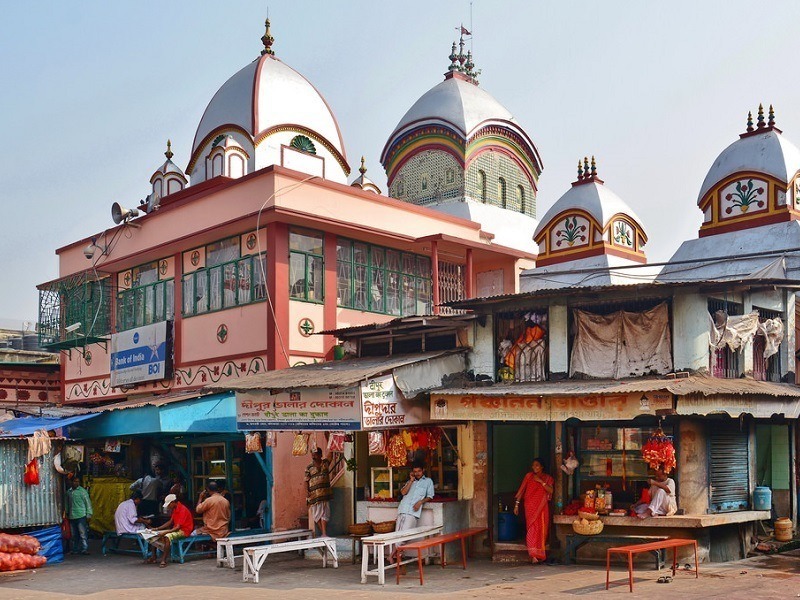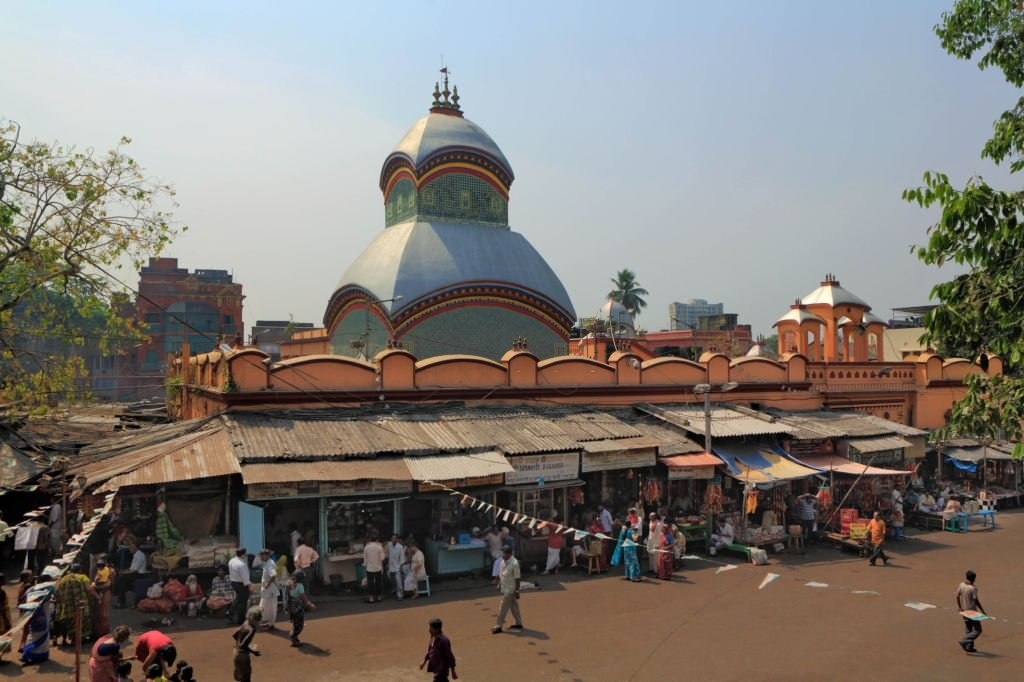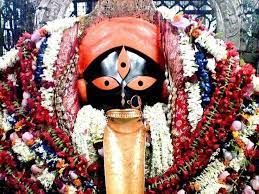
Kalighat Kali Temple
At the spiritual core of Kolkata stands the Kalighat Kali Temple, one of the city’s most ancient and revered shrines, where the powerful presence of Goddess Kali and the rhythm of daily rituals create an atmosphere of deep devotion. Believed to date back centuries, the temple remains a vibrant symbol of Bengal’s spiritual strength. The city comes alive during Durga Puja, its grandest festival, when devotion and artistry fill every street. Alongside its sacred heritage, Kolkata offers iconic attractions such as the majestic Victoria Memorial, the historic Indian Museum, the lush Alipore Zoological Garden, and the sprawling Botanical Garden with its famed Great Banyan Tree. Visitors can also explore the Birla Planetarium, delve into literary history at Jorasanko Thakur Bari, and experience the electric energy of Eden Gardens, one of the world’s most celebrated cricket stadiums. Together, these landmarks reflect Kolkata’s rich blend of spirituality, culture, history, and charm.
Historical background and Architectural splendor
The history of Kalighat Kali Temple dates back centuries, believed to have been initially built during the 12th century. Over time, the temple has witnessed various renovations and expansions, adapting to the changing times while retaining its religious sanctity. The name “Kalighat” is derived from the site’s association with the goddess Kali and the presence of a ghat (bank) on the Adi Ganga river.
The architectural splendor of Kalighat Kali Temple reflects a blend of traditional Bengali style with influences from different periods of reconstruction. The temple complex encompasses multiple chambers, corridors, and halls adorned with vibrant depictions of Hindu mythology and religious motifs. The main sanctum houses the imposing idol of Goddess Kali, capturing the essence of her fierce yet compassionate nature. Pilgrims and visitors marvel at the intricate detailing and craftsmanship displayed in the temple’s sculptures, creating an atmosphere that resonates with both historical significance and divine spirituality.

Religious Significance
This temple holds immense religious significance in Hinduism, particularly as a center for worshiping Goddess Kali. Devotees believe that the temple stands on the spot where the toes of the right foot of Goddess Sati, a form of Adi Shakti, fell during Lord Shiva's Rudra Tandava (Dance of Destruction). This association with a sacred legend adds to the divine aura of the temple. Goddess Kali, the principal deity of the temple, is revered as the embodiment of Shakti, representing the fierce and protective aspect of the feminine divine. The idol, adorned with a garland of skulls and standing on the chest of Lord Shiva, symbolizes the triumph of time over ignorance and the eternal power that conquers darkness. The temple is not only a place of worship but also a site for various rituals, pujas, and festivals dedicated to Goddess Kali. Pilgrims visit Kalighat seeking blessings, protection, and liberation from the cycle of life and death. The temple's religious significance is deeply embedded in the hearts of devotees, making it a revered destination for spiritual seekers and those seeking the divine grace of Goddess Kali.


Festival and Celebrations
Here the festivals celebrated are Kali Puja, Navaratri, Diwali, Saraswati Puja and Poila Boishakh (Bengali New Year).
Surroundings area & attractions
- Birla Mandir (Lakshmi-Narayan Temple): Situated in Ballygunge, Birla Mandir is a Hindu temple dedicated to Lord Krishna and Goddess Radha, known for its serene ambiance and intricate marble architecture.
- Dakshineswar Kali Temple: Located along the Hooghly River, Dakshineswar Kali Temple is another renowned Kali temple with a picturesque setting, attracting devotees and tourists alike.
FAQ
According to legend, the toes of Goddess Sati’s right foot fell at the spot where the Kalighat Kali Temple stands today. It is believed that the temple was later established to commemorate this divine event.
The river Adi Ganga flows near the Kalighat Kali Temple and is considered sacred by devotees. It is believed that taking a dip in the river before visiting the temple purifies the soul and enhances the spiritual experience.
The temple is open for devotees throughout the day, but certain times, such as dawn and dusk, are considered especially auspicious for worship. Devotees often visit the temple during these times to offer prayers and seek blessings.
The Kalighat Kali Temple is associated with numerous legends and miracles, as recounted by devotees over the centuries. These stories often revolve around the divine intervention of Goddess Kali in the lives of her devotees, granting them protection and blessings.
Animal sacrifices were once a common practice at the Kalighat Kali Temple, particularly during certain festivals. However, in recent times, the practice has been significantly reduced due to legal restrictions and changing social attitudes. Many devotees now offer symbolic sacrifices instead.
Yes, the temple priests perform special pujas and ceremonies for devotees seeking protection, blessings, or relief from specific problems or afflictions. These may include rituals like the Kali Puja, where devotees offer prayers and offerings to the goddess.
Yes, the Kalighat Kali Temple complex provides various facilities for pilgrims and visitors, including rest areas, drinking water facilities, and shops selling religious items and souvenirs. There are also nearby eateries and accommodation options for those staying in the area.
Devotees can make offerings or donations to the Kalighat Kali Temple by presenting them directly to the temple priests or dropping them in designated donation boxes. Additionally, online donation facilities may also be available for those who wish to contribute remotely.
The black stone idol of Goddess Kali is highly revered by devotees and is believed to embody the divine presence of the goddess. It is worshipped with great devotion and reverence during daily rituals and festivals.
Yes, visitors are often allowed to participate in certain rituals or ceremonies conducted at the temple, such as aarti (ritual worship with lamps) or offering flowers and prasad (sacred food) to the deity. However, it’s advisable to inquire with the temple authorities or priests for specific guidelines and arrangements.
The Kalighat Kali Temple is one of the most famous Hindu temples in Kolkata, dedicated to Goddess Kali. It is believed to be one of the 51 Shakti Peethas, where various parts of Goddess Sati’s body are said to have fallen.
Goddess Kali is a fierce manifestation of the divine feminine in Hinduism. She is often depicted with a dark complexion, wielding weapons, and standing over the body of Lord Shiva. She is worshipped as the destroyer of evil forces and the liberator of souls.
The exact date of the temple’s construction is not known, but it is believed to have existed for centuries. The current structure is said to have been rebuilt in the 19th century.
The temple is considered highly significant by devotees of Goddess Kali. It is believed to be a powerful site of worship where devotees come to seek blessings, protection, and liberation from worldly troubles.
The Kalighat Kali Temple is known for its daily rituals, including offerings of flowers, incense, and sweets to the deity. Additionally, various festivals are celebrated throughout the year, including Kali Puja, Durga Puja, Navratri, and Diwali.
Yes, the Kalighat Kali Temple is open to all visitors, regardless of their religious background. However, visitors are expected to follow the rules and customs of the temple, such as removing shoes before entering and maintaining decorum.
The temple features traditional Bengali architecture with intricate terracotta designs and sculptures adorning its walls. It has a simple yet elegant structure, with the main sanctum housing the idol of Goddess Kali.
Devotees can make various offerings to the deity, including flowers, fruits, sweets, and coconuts. It is also common for devotees to offer prayers, perform rituals, and seek blessings for their well-being and prosperity.
Photography rules may vary, but generally, photography inside the temple may be restricted, especially near the sanctum sanctorum where the deity is worshipped. It’s best to inquire with the temple authorities or priests regarding photography guidelines.
Visitor information
Entry Fee: No fee
Timings :
- 5 am -2 pm
- 5 pm -10.30 pm
Darshan Days- All days
Address:
Kalighat Kali Temple 2, Kalighat Road, Kalighat, Kolkata, West Bengal - 700026, India.
Notable Events and Incidents
- Mysterious Disappearance of the Original Idol: There is a legend that the original idol of Goddess Kali at Kalighat Temple mysteriously disappeared, and a newer idol was consecrated in its place.
Connectivity :
- By Air: Netaji Subhas Chandra Bose International Airport is the nearest airport, located approximately 20 kilometers away from Kalighat Kali Temple.
- By Rail: Howrah Junction and Sealdah Railway Station are the major railway stations in Kolkata.
- By Road: Kolkata has a well-connected road network, and Kalighat Kali Temple is accessible by buses, taxis, and private vehicles.
